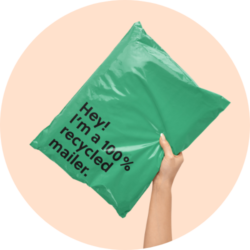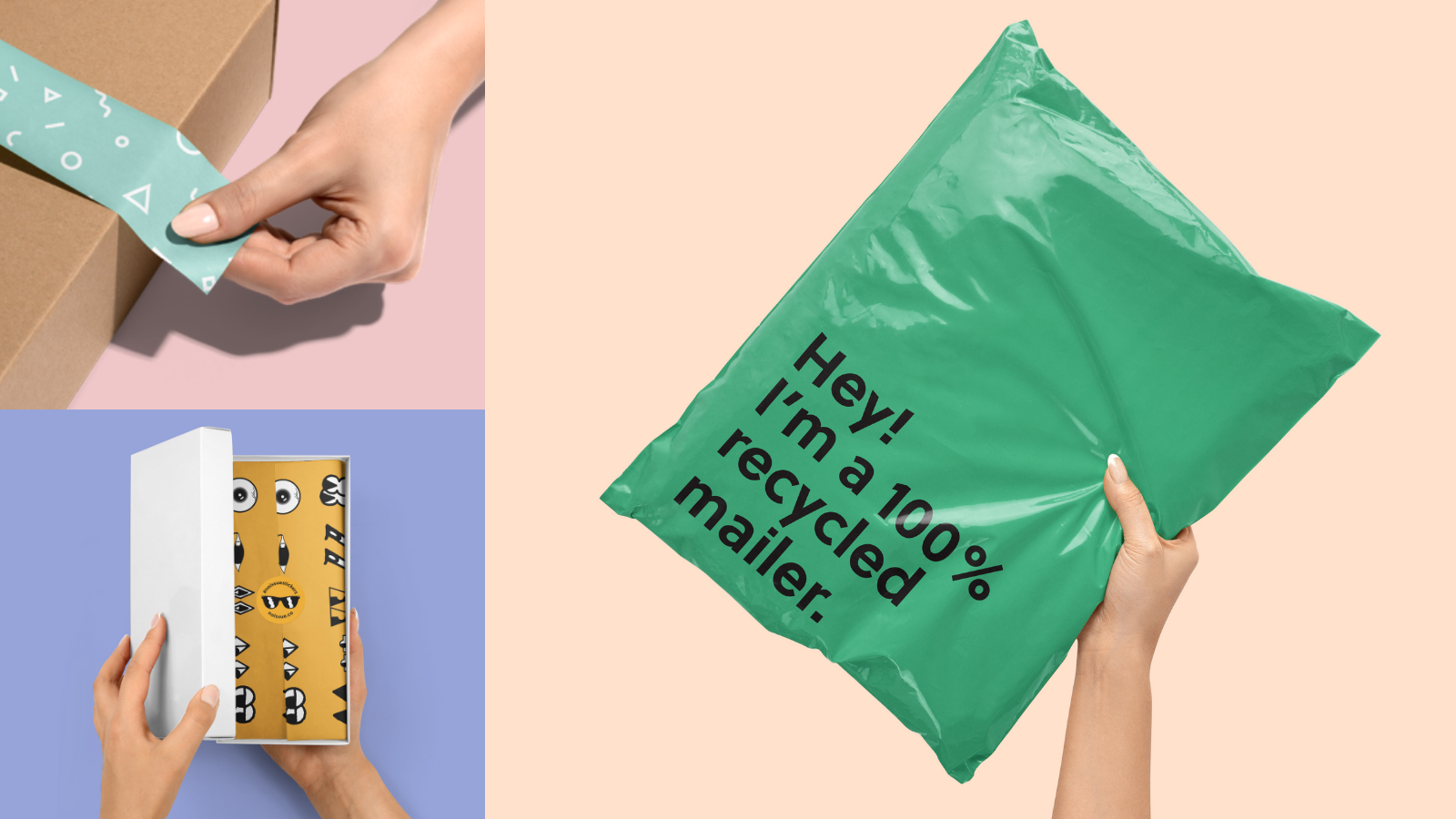Table of Contents
** Minutes
What is eco-friendly shipping?
Global impact of shipping on the environment
9 green shipping best practices for ecommerce
Benefits of implementing eco-friendly shipping supplies
Online shopping has boomed in the pandemic, and the ability to have packages delivered right to a customer’s doorstep has become more popular than ever.
With the increase of online shopping, it has some people asking, “But what about the impact packaging and transportation has on the environment?”
As online shopping continues to become an essential part of our daily lives, it’s critical to consider the waste it brings with it. Additionally, it’s equally important to recognise the movement towards a more sustainable online retail experience, and it should be top of mind for all ecommerce brands.
As a business, you may have wondered, “What can I do to offset my business’s carbon footprint?” Below we share how eco-friendly shipping can help this cause and some of the ways brands are offsetting their carbon footprint.
What is eco-friendly shipping?
Eco-friendly shipping includes the use of biodegradable material that can easily be recycled, used for other purposes, and don’t take as long to decompose for packaging and shipping products.
It can also refer to consolidating orders into single shipments, using low carbon-emitting methods of transportation, and other ways of minimising the impact delivering packages has on the environment.
Global impact of shipping on the environment
The convenience, speed, and ubiquity are what make online shopping and 2-day shipping so appealing. However, the unfortunate reality is that there is a dark side to ecommerce. The negative impact on the planet will only increase as ecommerce sales double over the next decade.
The global impact of shipping on the environment is eye-opening. A recent study shows that Amazon emits nearly as much carbon dioxide as a small country, and almost a third of the solid waste in America comes from ecommerce packaging. And that’s not all:
165 billion packages = 1 billion trees
On average, there are about 165 billion packages shipped in the United States each year. The cardboard used for these packages roughly equates to 1 billion trees. That statistic doesn’t factor in the other types of packaging, like plastic, which is even less eco-friendly than cardboard.
Black carbon emissions total 21%
Black carbon, or soot, is part of fine particulate air pollution that contributes to climate change. Black carbon is one of many particles and gases emitted when diesel, coal, and other biomass fuels are burned.
Black carbon is produced by ships that burn heavy fuel oil and is one of the biggest drivers of the negative impact of shipping globally. Efforts to reduce black carbon emissions will bring immediate benefits for human health and the climate since black carbon does not last long in the environment.
7,500,000 extra plastic bags
In the ecommerce world, some companies are using bubble mailers and plastic bags because they are lighter and allow for more packages to fit on trucks and planes. Ultimately, this saves them operative and packaging costs.
According to Adept Packaging, ecommerce sales resulted in 7,500,000 extra plastic bags. It can take plastics anywhere from 20 to 500 years to decompose under the right circumstances, depending on the structure and material. It’s possible that plastics used in packages in 2021 could still be on Earth in 2521.
That’s why it is crucial for ecommerce brands and logistics companies to rethink the materials and packaging they use to ship their products.
Fast delivery is a significant contributor to climate change
Fast delivery without leaving home is arguably the biggest appeal of the ecommerce industry, and it also gives brands a competitive advantage if they offer 2-day or less shipping.
Behind the scenes of fast shipping are the harmful effects it has on the environment. Last-mile delivery, close behind freight movement, is one of the fastest-growing sources of greenhouse gas emissions and local air pollution.
To offset this, encourage your customers to take control of their deliveries by making sure they are home during delivery windows, utilise tools from couriers like UPS to have more visibility, and even designate pickup spots.
Increasing ecommerce return rates
Returns have notoriously been a headache for both the merchant and consumer. Companies like Returnly have filled the gap by offering a robust exchange and return experience for customers, ultimately bettering the overall customer experience.
While it’s become the norm to provide a convenient return experience for the shopper, it negatively impacts the environment by increasing transportation and materials.
9 green shipping best practices for ecommerce
Taking a stance on sustainability and changing the business model of your ecommerce company is no longer an option for reaching the modern customer. In fact, according to a recent survey:
- 87% of consumers will have a more positive image of a company that supports environmental issues.
- 92% will be more likely to trust a company that supports environmental issues.
As a small to midsize business, it may feel overwhelming to compete with large retailers like Amazon to be more sustainable. A third-party logistics (3PL) company like ShipBob can help provide tools and processes that will result in environmental and operational efficiency.
While some brands have been known to get very creative when it comes to identifying eco-friendly shipping methods and other sustainability practices, here are nine ways you can lower the carbon footprint for your online store:
1. Opt for eco-friendly packaging
Packaging is necessary to get orders delivered safely while preventing shipping damages. Like plastic bags and bubble wrap, the packaging you choose can contribute greatly to retail packaging waste.
Luckily, there are eco-friendly options that help you make smarter and more sustainable choices that are better for the future of our planet. Keep your carbon emissions as low as possible by opting for sustainable packaging and shipping materials like compostable mailer bags and biodegradable packaging peanuts.
When using eco-friendly packaging to ship your products, you use eco-friendly materials including boxes, mailers, and other supplies to minimise the impact on the environment.
“Since the day we started Open Water, every decision has been made with sustainability in mind, from our 100% recyclable aluminum packaging to our most recent initiative: climate neutral certification. It’s incredibly important to us to work with partners who share our values, so we couldn’t be more excited that ShipBob is making this critical climate commitment.”
Jess Page, Co-founder & Chief Brand Officer of Open Water
2. Offer customers the option to offset carbon during checkout
Carbon offsetting is a way to reduce the harmful effects of a specific carbon-emitting activity through funding projects and ventures designed to soak up the resultant emissions, give back to severely impacted communities, and even reduce future emissions.
The likelihood of a business being able to cut out certain carbon emissions activities completely is low. Carbon offsetting acknowledges this and allows you to minimise the effects of those emissions and still help contribute to a more sustainable future.
ShipBob partners with Ecocart so you can purchase carbon credits by allowing your customers to choose (and optionally, pay for) carbon offsets on a per-order basis, and allowing you to offset the carbon impact of product manufacturing and even last-mile delivery.
“Our business is built on sustainability and we aim to provide our customers with carbon-neutral products from our natural sources to their front door. That is why we work with ShipBob to offset carbon emissions from our ecommerce supply chain.
Minimise upfront investment and maximise positive impact on the planet by utilising the simplest way to incorporate sustainability into your brand’s operations, carbon offsetting.”
Fannar Jonsson, Quality and Environment Manager at Blue Lagoon Skincare
3. Reduce your packaging size
Ensure your packages are packed as efficiently as possible by reducing the box size and packaging materials (as long as it’s not too tight and can damage your products).
Not only does this reduce a shipment’s dimensional weight and overall costs, but it also helps you cut back on waste. Packing a small item in a big box is a common packing mistake businesses make, and one that consumers are quick to notice.
4. Offer a sustainable returns program for your products
Reduce your carbon footprint by offering a more sustainable returns process for your products. Creating a mutually beneficial returns program is a win-win for both you and the customer.
ShipBob is also proud of our partnership with GiveNKind, a nonprofit organisation that recovers usable goods from businesses that want to donate their products, and makes those goods available at no cost to local nonprofits.
 5. Implement compostable mailers
5. Implement compostable mailers
If you’re serious about taking the next steps to become a more sustainable ecommerce business, investing in compostable mailers is a great alternative to plastic mailer bags. Plus, you can use your company’s branding to add a personalised unboxing experience for your customers!
These mailers are made from recycled plastics and align with the commitment of sustainability within the ecommerce industry. There is also a second adhesive strip, so the mailer can be used once more.
6. Push ground-based shipping when possible
To decrease the number of shipping days, you can take a data-driven approach to be in fulfilment centres near your customers while reducing the average shipping zones you ship to. This gets you closer to your customers to reduce overall transportation routes. You can even choose not to use expedited air shipping and offer affordable ground shipping, which means customers will wait longer but some may be fine with that.
7. Ship a package in the box itself
Have you ever received a shipment that was delivered in its actual packaging and not a plain brown box?
The shipper didn’t forget to throw the item in a box; This was done intentionally to reduce packaging used.
This shipping technique is referred to as “ships in own container” (SIOC). SIOC is a form of product packaging in which a product ordered can be shipped to the customer in its original packaging, without any additional packaging required such as an overbox.
Utilising this form of product packaging can not only provide a more sustainable packaging option, but it also lowers packaging costs and gives a better customer experience.
8. Encourage customers to reuse and recycle packaging
Packing materials is very eco-friendly because it can be reused over and over again for shipments. Having open communication with your customers on ways they can use reuse packaging materials for their personal shipping will empower them to also play a part in saving the planet.
Even encourage your customers to recycle or give them instructions on how to ensure materials can break down, especially during the holidays.
9. Distribute your inventory with a tech-enabled 3PL
Distributing inventory means you store inventory in more than one region, so that each time an order is placed on your store, the distribution centre closest to that customer will automatically fulfil the order.
When you distribute your inventory through a tech-enabled 3PL like ShipBob, you are able to ship your packages the shortest possible distance, cutting back on long routes as much as possible in the shipping process.
ShipBob’s tech-enabled model even helps you keep enough products in stock across locations with various inventory tools. This helps prevent the need to ship different items from different logistics centres, which helps ensure only one box is used, eliminating partial shipments (also known as split shipments).
Benefits of implementing eco-friendly shipping supplies
Even if they start as small changes, implementing any of the nine ideas above for green shipping can greatly benefit your ecommerce business.
Some online store owners are hesitant to implement these changes in fear of losing current customers due to the increase in prices to compensate for more sustainable practices. However, it’s important to note the stats behind it:
Over two-thirds of purpose-driven shoppers will pay an added premium of 35% or more for sustainable purchases, such as recycled or eco-friendly goods.
To add, 73% of consumers would change consumption habits if it meant reducing their impact on the environment.
Not only are you doing great things for the environment, but you could tap into a new market of customers. Here are a few of the benefits of implementing eco-friendly shipping supplies:
Your customers choose environmentally-friendly businesses
As retail trends become more digital, brands that own and actively better their operations to help the planet will come out on top. Millennials and Gen Z are driving this push towards online shopping, and statistics behind it are interesting:
- 67.1% of millennials that were surveyed either sometimes or always check a brand’s sustainability and ethics practices before deciding to purchase from them.
- According to Business Insider, people feel proud knowing that they’re offsetting potential environmental impacts while shopping.
Social media is giving people access to endless information, so it’s only logical that there’s a movement for bettering the planet by preferring to shop for sustainable and green products, as well as shopping to make an impact.
Leading by example to a greener future is more important now than ever.
Green shipping can save you money
While the initial investment could require you to shift around your budget, green shipping can save you money once the changes have been made.
The ethos behind green shipping is only to use the material that you need and avoid waste at all costs. This means that you will save money on extra shipping materials you would typically pay for with unnecessary packaging material.
Practice what you preach
When your ecommerce store implements greener options like biodegradable shipping options, you join the ranks of other companies that are working towards a greener ecommerce landscape! You can show off your new, eco-friendly packaging and showcase the ways you are decreasing your carbon footprint.
You can even jump on the train of creating a TikTok for your business. You could be the next viral ecommerce brand on the app for your help in saving our planet!
But note — consumers are not afraid to call out brands that promote their sustainability efforts just for marketing purposes, so be sure you walk the talk.
How partnering with ShipBob enables green shipping options
If a merchant wants to be 100% carbon neutral in their fulfilment, they can outsource fulfilment to ShipBob and install the Ecocart app from the Shopify App Store (or build a custom integration into ShipBob) to automatically offset their own carbon footprint from their last-mile delivery to have a fully carbon-neutral logistics chain. ShipBob has also taken care of our emissions from offices and our entire fulfilment centre network to cover all back-office operations.
ShipBob also partners with packaging companies like noissue and Packlane to provide merchants with custom, eco-friendly packaging that ShipBob can use on their behalf during the order fulfilment process.
If you choose to use ShipBob’s plain standard packaging, note that we do use recycled kraft paper as our dunnage, the durable padding material used to protect goods during shipping, as this is much better for the environment than bubble wrap or packing peanuts.
Eco-friendly shipping FAQs
Here are some of the most frequently asked questions about eco-friendly shipping:
How do you ship eco-friendly?
There are a multitude of ways that you can ship eco-friendly, all depending on your company’s bandwidth and resources. To start out, you can offer customers carbon offsets during checkout. This is the most popular method for reducing your carbon footprint in a manageable and affordable way.
Additionally, you can opt for eco-friendly packaging, reduce package size, use the “ships in own container” product packaging, and distribute your inventory with a tech-enabled 3PL like ShipBob to reduce transit routes.
What is the most eco-friendly packaging?
The eco-friendly packaging alternatives range depending on the needs of your ecommerce business. Some of these packaging options include;
- Compostable mailers
- Corrugated cardboard
- Biodegradable packaging peanuts
- Air pillows made of recycled materials
- Cornstarch packaging
- Recycled craft paper
Which 3PLs offer eco-friendly options?
ShipBob provides merchants eco-friendly options. If a merchant wants to be 100% carbon neutral in their fulfilment, they can outsource fulfilment to ShipBob, install the Ecocart app from the Shopify App Store to automatically offset their own carbon footprint from manufacturing and the last-mile delivery, utilise eco-friendly packaging, and more.
Note: ShipBob offsets all the carbon emissions from our headquarters and entire fulfilment network.
What are compostable mailers?
Compostable mailers are a great alternative to plastic mailer bags. These mailers are made from recycled plastics and align with the commitment of sustainability within the ecommerce industry. There is also a second adhesive strip, so the mailer can be used once more.

 5. Implement compostable mailers
5. Implement compostable mailers

